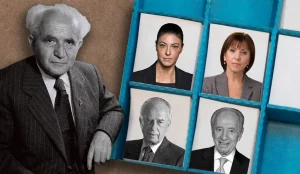How and Why Israelis Stopped Voting for the Left

Clockwise from left: David Ben-Gurion, Merav Michaeli, Zehava Galon, Shimon Peres and Yitzhak Rabin.
Alon Pinkas writes in Haaretz, 24 Augusr 2022, “In the last 20 years, Israel has had nine elections. The upcoming November 1 election will be the 10th in the cycle, and before every single one of these campaigns, the same questions were raised: “What’s the problem with the left?” “What happened to the left?” “What’s left of the left?”
A derivative question – often asked by American Jews – is: “Who are and where are the Israeli liberals?” Not “liberal” in the U.S. political sense, but liberal democrats. Some ask it gloatingly, some in desperation, others out of political curiosity and astonishment. How could the historic Israeli left, a political movement that successfully founded and led the country against all odds, dissolve so quickly and be relegated to political insignificance?
The only social democratic movement in history that established a country and developed a functioning and durable democracy is on the precipice of oblivion. The Labor Party and Meretz (a third-generation descendant of old Labor) are the remnants of a political force that built and ran Israel. Together, they have 13 seats in the outgoing Knesset – a number that is unlikely to grow come November.
It is very tough, depressing, dispiriting and often politically lethal for a political party entrenched in history to transition from a dominant policymaker, agenda setter and opinion shaper to marginal advocate with minimal impact on national policies, diminishing appeal and sharply dwindling influence on the electorate. For a variety of avoidable and inexorable reasons, this is exactly what has happened to the Israeli left. There are historical and political causes that explain its decline and fall. In no particular order of importance or level of impact, here are the five trends that determined the Israeli left’s political fate…
Identity politics
The label “left” has become a political code word, a cultural euphemism and dog whistle of sorts to describe, generally, “everything that I am not” and, ergo, “everything that I am against.” It started with the decline in influence and diminishing dominance of the Israeli WASP: White, Ashkenazi, Sabra, Paratrooper. These are the people who founded the State of Israel and occupied most, if not all, of the key positions in the defense, intelligence and political establishment, as well as in the economy and culture.
But that decline, precipitated by both demographic and ethnic trends and Likud leader Menachem Begin’s election victory in 1977, later metamorphosed into a much more visceral and divisive trend: the distinction between “Jew” and “Israeli.” While advising Benjamin Netanyahu, political consultant Arthur Finkelstein expressed it as a pure political equation: Ask someone if they are “more Jewish” or “more Israeli.” If they answer “Israeli,” they are leftists and we are “Jews.”
That would be the rough equivalent of those “real Americans” who, of course, love America, versus those “coastal liberal elites” who are constantly critical of their country and therefore don’t really love America. According to this division, Jews love Israel unconditionally, will always believe Israel is right, have a communal sense of togetherness and shared fate, respect Jewish tradition, verge on being “religious light,” will always be suspicious of Arabs and dislike the world.

Then-Prime Minister Benjamin Netanahu and wife Sara with political consultant Arthur Finkelstein in 1999
Anti-elitism
The elites are “left,” by nature and by definition. The Israeli “left” is, in European terms, economically and socially “right” – but that doesn’t matter because of cynical identity politics. The military high command, the justice system and academia are all “left.” If you are the chief of staff of the Israel Defense Forces, a district court judge, chairman of a bank, developer or CEO of a high-tech company, history or physics professor at a university or head of the cardiology department at a hospital, you are the elite. And the elite is “left.” The elites discriminated against our parents and grandparents who were treated as perennial second-class citizens, never sharing in power, so the argument goes. We vote against the elites, it’s that simple.
A person who supports ending the occupation is a leftist. But so is the one going to the opera, the one reading Haaretz and the one who dislikes the ultra-Orthodox not serving in the military and enjoying substantial government stipends.
The populist, demagogic and deliberately incendiary discourse of the Netanyahu years – much like Trump in the United States and other quasi-authoritarians throughout the world – contributed to the creation of an unbridgeable chasm between “the left” and mainstream Israelis. The chasm was never real, but it was effectively and artfully executed. It is immaterial that Likud has been in power for most of the last 45 years. The entitled, privileged “elites” control the country, try to impose and dictate values.
In other words, the “left” still rules. The least we can do is not vote for them. Second- and third-generation prospective center-left voters don’t want to be associated with the negative connotation that “left” has, so they vote for the flavor-of-the-election centrist party.
The peace process
The Israeli left was always identified with a “peace process.” Critics and detractors will correctly point to the Israeli left’s complicity in both the occupation, the settlements and the failure to find a solution. Yet the left’s political sins, mistakes and misjudgments pale in comparison to the political and nationalistic right.
But the left made a colossal strategic mistake when communicating to Israelis the imperative necessity to disassociate from the Palestinians. By conflating “peace” with “end of occupation,” it committed two major errors: promising the unattainable; and being identified more with the rights of the Palestinians than with the plight and suffering of Israelis during a “peace process” era replete with heinous and murderous acts of terrorism.
Against the background of a failing and collapsing peace process, rather than revisit and rewrite a foreign policy and defense narrative, recalibrate and make the necessary adjustments, the left’s response was to double down on the Palestinian issue. It was Prime Minister Ariel Sharon – hardly a “leftist” but always a pragmatist – who chartered a map to end the occupation without the flowery political poetics of peace. Once he left the political scene in 2006, the course was set. There was no longer a viable “left.”

Ariel Sharon speaking after Likud’s victory in the 2003 Knesset election. The course was set after he departed the political scene in 200
Comfort zone
Israelis are by-and-large centrists. They are middle of the road, “I don’t trust the Palestinians, nor do I want to control, let alone annex, the territories.” Ever since Sharon, that magical formula was offered to them by “the center”: a series of parties, from Sharon and Ehud Olmert’s Kadima to Kahol Lavan in 2019-2021, to current Prime Minister Yair Lapid’s Yesh Atid, that promised a comfort zone, delivered nothing, yet the jaded and disillusioned Israeli found comfort there. We dislike the nationalistic right-wing profoundly, we despise Netanyahu, we no longer believe in the left. What’s left? The nondescript center.
Message versus messengers
There’s a prevailing myth that “Israel moved sharply to the right.” It is based on two simple determinations: Israelis no longer believe in a peace process; and if you subtract the Arab voters (20 percent of the population), you’ll get a clear right-wing, extreme right-wing and religious majority. Even without the fallacy of subtracting the Arab vote, this is wrong. If you take right-wing elements in the anti-Netanyahu coalition and add them to the total right-wing numbers, you’ll get a right-wing majority. True.
But if you hold a referendum on: annexing the West Bank (Judea and Samaria), one binational state for Israeli Jews and Palestinian Arabs, and deconstructing the Israeli welfare state, including universal health care (established, by the way, by “the left”), you are likely to get at least a 60 percent NO vote.
Israelis haven’t rejected the left’s message, but they have comprehensively repudiated the left’s political messengers. The Israeli left has done very little to change that and when it tried, it hit the “anti-elitism” brick wall. So, around 50 percent or more of Israelis generally espouse “left” positions on issues of war and peace and social democracy, yet only 11 percent vote for left-wing parties. That is the reality of contemporary Israeli politics, and it is not about to change.” This article is printed ibn its entirety.
